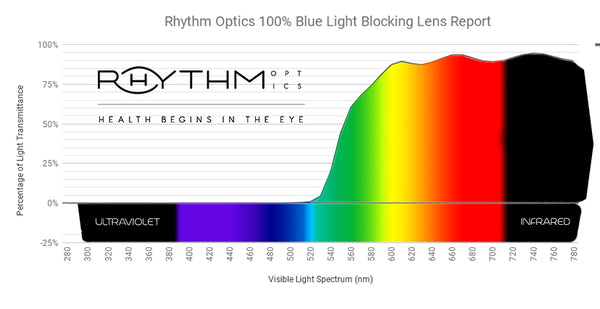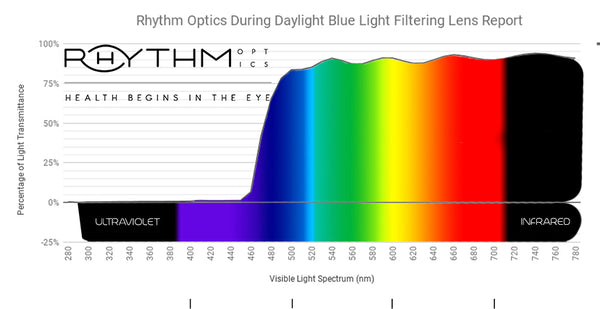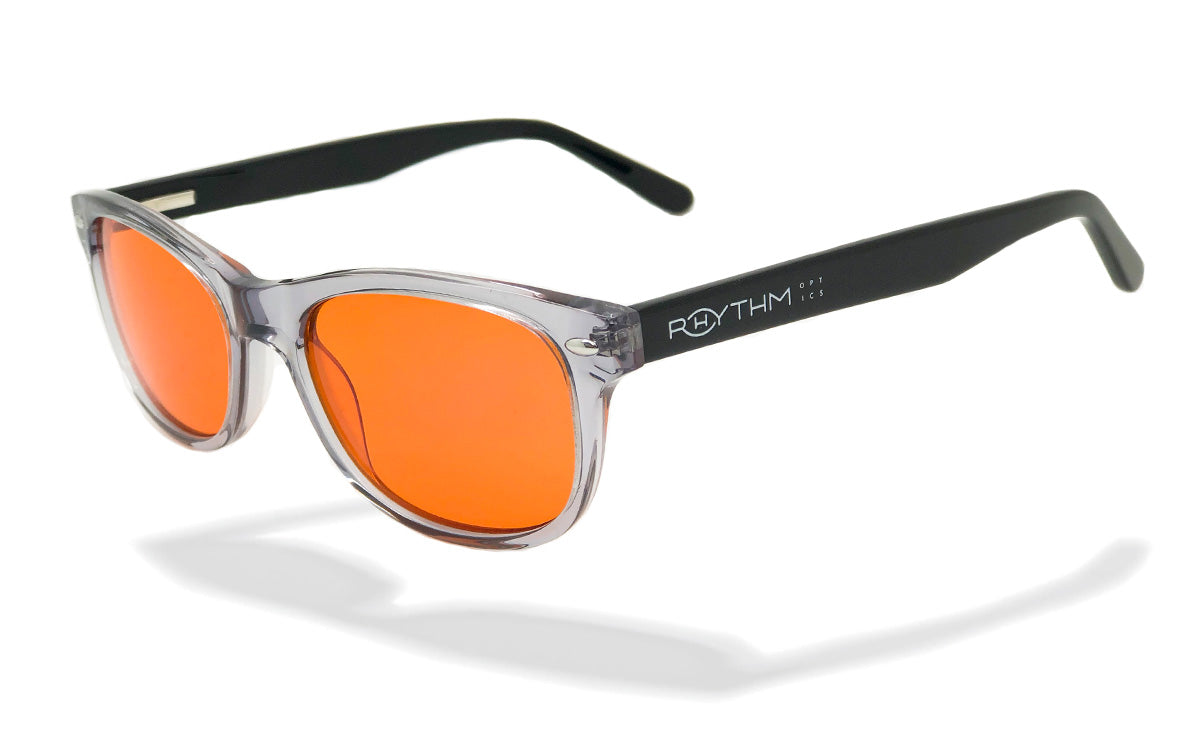About Our Lenses
Are you finding yourself confused about all the different blue light blocking glasses out there?
There are clear lenses, light yellow lenses, dark yellow lenses, orange lenses and even red lenses and all sorts of claims being made.
Do they block blue light? How much do they block? Do they block all blue? What about green? Do the really block, or just filter? What's the difference between block and filter?
Unlike most eyewear brands, we decided the best thing to do is just be totally transparent about our lens specifications. We know the results speak for themselves.
First up, we think it's important to be clear about the terminology used. We believe that if you are going to claim to "Block" a colour spectrum, it's all or nothing. Otherwise it is only filtered, not blocked. So anything less than 100% would be filtering. Many anti-blue light glasses will suggest an "nm" number, but without stating what percentage of light transmits at that nm, then you don't really know what relevance the nm figure has... For example, does a 550nm lens, block 100% of light at 550nm, or does it let in 5, 10, or even 30% of light at 550nm? Without that information it is not clear what they actually do.
It's a bit like marketing a sportscar and saying "it accelerates to 100mph" or, "it accelerates from 0-100mph in 4.3 seconds". The former might be true, but has no context by leaving out "by what method" the claim is made. The latter is specific and leaves no room for half truths.
And as light is measured across a spectrum, knowing what transmits through the lens in increments is important too. It's not about one single measurement. Knowing what percentage of light transmits through the lens across the entire visible light spectrum is key to understanding how they actually perform.
The best way to visualize that data is with a transmission curve report.
Currently, we offer 4 lens choices. Our During Daylight collection which has a stronger, visibly dark yellow lens and an almost clear lens. Our After Sundown collection which has a stronger visibly dark red lens, and an orange lens.
We exist to help you optimize your circadian rhythm and improve your health, not to cash in on the trending idea of blue light glasses by selling you half truths. Some eyewear makers are selling only clear lensed glasses that only filter out a small portion of blue light, usually 10% - 20%. Some decide to take their measurement at 1/2 way through the blue light spectrum and then claim they block 50%! So be mindful of the language used. Blocking 50% at 400 to 450nm but then letting in 70-90% from 450-500nm is not blocking 50% of blue light!
By only being effective in the lower range of the blue light spectrum they have little bearing on Melatonin and circadian rhythm. They simply don't block anywhere near enough blue light to be effective for anything more than taking the edge of screen use during the early half of the day. They are a nice fashion accessory though...
The only way to truly know what a lens does and doesn't do is to view a spectral transmission report. One from a certified lab, not an iphone app.
After Sundown Collection

Our After Sundown collection offers 2 lens choices.
Rhythm500 Amber Lens
The Rhythm500 lens has been developed to block 100% of the harmful ultraviolet, violet and the blue light spectrum. At 490nm, the peak of Blue Light Spectrum[1] it transmits 0.00% of visible light. At 500nm it transmits 0.10%. At 510nm it transmits 0.28%. At 530nm it transmits 4.39%. At 540nm it transmits 19.94%.And by 550nm it transmits 44.7% of the visible light spectrum. So it not only blocks out all blue light, it also filters out of the lower half of green light. It then tapers off allowing yellow, orange and red through.
[1]https://en.wikipedia.org/wiki/Color#Physics_of_color - Craig F. Bohren (2006). Fundamentals of Atmospheric Radiation: An Introduction with 400 Problems. Wiley-VCH. p. 214.

Click here to download the full Rhythm500 pdf lab report
This formula makes artificial blue light at night from device screens and LED lighting be interpreted biologically more like a campfire or candle light would. Think of it as 'paleo light', like what our ancestors would have experienced before the introduction of electricity and modern lighting.
Why did we choose this lens?
Sure, we could have gone more powerful. By shooting to filter out a larger amount of green, that would make the lens a very dark red tint. We found in testing, such an extreme tint is less user friendly. The tendency is to wear it for a lesser amount of time as sleepiness will kick in fast. Lets say the sun goes down at 6:30...if you put them on then you'll probably be asleep by 7:30! Not ideal for most. The temptation then becomes to not put them on until later, but that leaves you open to more blue light exposure after sundown up until you do. Also not ideal.
The Rhythm500 lens is deliberately in the sweet spot of being both effective and useable.
Rhythm560 Red Lens
Our stronger night time lens, the Rhythm560 was developed for the hardcore biohacker! A full red lens developed for maximum melatonin preservation. These are for the most serious blue and green light blocking biohacker!
By blocking out blue light and green light right up to 99.64% at 560nm, you will avoid virtually all light that has the ability to suppress melatonin.

Click here to download the full Rhythm560 lens pdf lab report
During Daylight Collection

Rhythm450 Yellow Lens
For use during daylight hours we developed the Rhythm450 lens. A darker yellow than typically seen on gaming glasses or computer glasses. And far removed from the clear glasses you might see marketed as blue blocking glasses.
This "yellow" lens filters out all but 1.2% of blue light at 440nm. At 450nm it is 1.3%, at 460nm it is 6.7% and at 470nm begins to allow more in at 41.8% and progresses up from there.

Click here to download the Rhythm450 lens lab report
Why would I use these glasses when the other lens is more effective?
Unless you want to fall asleep under your desk during the day like George Costanza, the After Sundown lenses are best saved for the right time of the day. Remember, this all all about circadian rhythm and chronobiology. You want the right signals at the right time of day. This lens is great from middle of the day to early-afternoon and onwards. It will begin to taper off your light exposure heading toward evening. Picture still working on the computer at 5:30pm with the screen signalling to you body clock that it is still noon... you don't want that!
We have tested this lens as ideal for heavy daytime computer use in artificially lit offices or similar environments. It is the optimal compromise of blue light protection without causing drowsiness.
To shop our During Daylight collection, click here.

